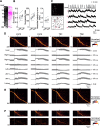Layer 5 Intratelencephalic Neurons in the Motor Cortex Stably Encode Skilled Movement
- PMID: 37699714
- PMCID: PMC10601372
- DOI: 10.1523/JNEUROSCI.0428-23.2023
Layer 5 Intratelencephalic Neurons in the Motor Cortex Stably Encode Skilled Movement
Abstract
The primary motor cortex (M1) and the dorsal striatum play a critical role in motor learning and the retention of learned behaviors. Motor representations of corticostriatal ensembles emerge during motor learning. In the coordinated reorganization of M1 and the dorsal striatum for motor learning, layer 5a (L5a) which connects M1 to the ipsilateral and contralateral dorsal striatum, should be a key layer. Although M1 L5a neurons represent movement-related activity in the late stage of learning, it is unclear whether the activity is retained as a memory engram. Here, using Tlx3-Cre male transgenic mice, we conducted two-photon calcium imaging of striatum-projecting L5a intratelencephalic (IT) neurons in forelimb M1 during late sessions of a self-initiated lever-pull task and in sessions after 6 d of nontraining following the late sessions. We found that trained male animals exhibited stable motor performance before and after the nontraining days. At the same time, we found that M1 L5a IT neurons strongly represented the well-learned forelimb movement but not uninstructed orofacial movements. A subset of M1 L5a IT neurons consistently coded the well-learned forelimb movement before and after the nontraining days. Inactivation of M1 IT neurons after learning impaired task performance when the lever was made heavier or when the target range of the pull distance was narrowed. These results suggest that a subset of M1 L5a IT neurons continuously represent skilled movement after learning and serve to fine-tune the kinematics of well-learned movement.SIGNIFICANCE STATEMENT Motor memory persists even when it is not used for a while. IT neurons in L5a of the M1 gradually come to represent skilled forelimb movements during motor learning. However, it remains to be determined whether these changes persist over a long period and how these neurons contribute to skilled movements. Here, we show that a subset of M1 L5a IT neurons retain information for skilled forelimb movements even after nontraining days. Furthermore, suppressing the activity of these neurons during skilled forelimb movements impaired behavioral stability and adaptability. Our results suggest the importance of M1 L5a IT neurons for tuning skilled forelimb movements over a long period.
Keywords: encoding/decoding; intratelencephalic neurons; motor cortex; motor learning; skilled forelimb movement; two-photon imaging.
Copyright © 2023 Shinotsuka et al.
Figures







Similar articles
-
Two distinct layer-specific dynamics of cortical ensembles during learning of a motor task.Nat Neurosci. 2014 Jul;17(7):987-94. doi: 10.1038/nn.3739. Epub 2014 Jun 1. Nat Neurosci. 2014. PMID: 24880217
-
Distinct Laterality in Forelimb-Movement Representations of Rat Primary and Secondary Motor Cortical Neurons with Intratelencephalic and Pyramidal Tract Projections.J Neurosci. 2017 Nov 8;37(45):10904-10916. doi: 10.1523/JNEUROSCI.1188-17.2017. Epub 2017 Oct 2. J Neurosci. 2017. PMID: 28972128 Free PMC article.
-
Disengagement of Motor Cortex during Long-Term Learning Tracks the Performance Level of Learned Movements.J Neurosci. 2021 Aug 18;41(33):7029-7047. doi: 10.1523/JNEUROSCI.3049-20.2021. Epub 2021 Jul 8. J Neurosci. 2021. PMID: 34244359 Free PMC article.
-
Skilled forelimb movements and internal copy motor circuits.Curr Opin Neurobiol. 2015 Aug;33:16-24. doi: 10.1016/j.conb.2014.12.009. Epub 2015 Jan 10. Curr Opin Neurobiol. 2015. PMID: 25588912 Free PMC article. Review.
-
The acquisition of skilled motor performance: fast and slow experience-driven changes in primary motor cortex.Proc Natl Acad Sci U S A. 1998 Feb 3;95(3):861-8. doi: 10.1073/pnas.95.3.861. Proc Natl Acad Sci U S A. 1998. PMID: 9448252 Free PMC article. Review.
Cited by
-
Developmental timecourse of aptitude for motor skill learning in mouse.bioRxiv [Preprint]. 2024 Dec 21:2024.07.19.604309. doi: 10.1101/2024.07.19.604309. bioRxiv. 2024. PMID: 39071410 Free PMC article. Preprint.
-
Dopamine-mediated plasticity preserves excitatory connections to direct pathway striatal projection neurons and motor function in a mouse model of Parkinson's disease.bioRxiv [Preprint]. 2024 May 30:2024.05.28.596192. doi: 10.1101/2024.05.28.596192. bioRxiv. 2024. PMID: 38854096 Free PMC article. Preprint.
-
Cortico-basal ganglia plasticity in motor learning.Neuron. 2024 Aug 7;112(15):2486-2502. doi: 10.1016/j.neuron.2024.06.014. Epub 2024 Jul 12. Neuron. 2024. PMID: 39002543 Free PMC article. Review.
-
Effective training procedure for a simultaneous bimanual movement task in head-fixed mice.Front Neural Circuits. 2025 Aug 8;19:1633843. doi: 10.3389/fncir.2025.1633843. eCollection 2025. Front Neural Circuits. 2025. PMID: 40862209 Free PMC article.
References
-
- Arthur WJ, Bennett WJ, Stanush PL, McNelly TL (1998) Factors that influence skill decay and retention: a quantitative review and analysis. Hum Perform 11:57–101. 10.1207/s15327043hup1101_3 - DOI
Publication types
MeSH terms
LinkOut - more resources
Full Text Sources
Molecular Biology Databases
Research Materials
